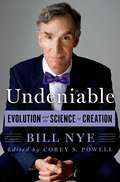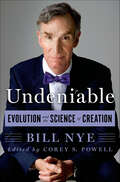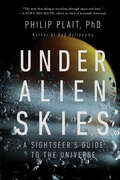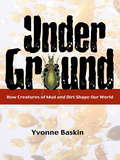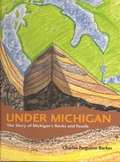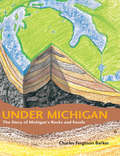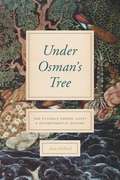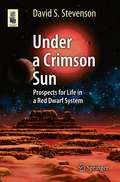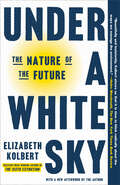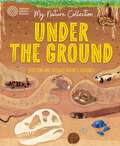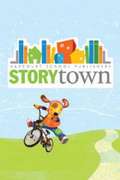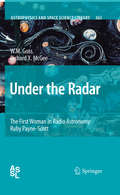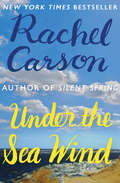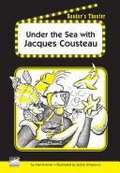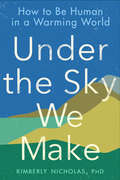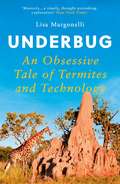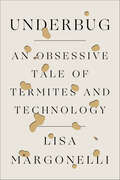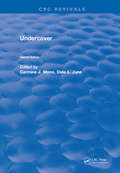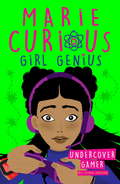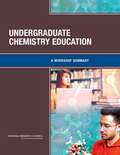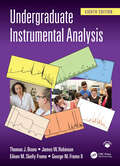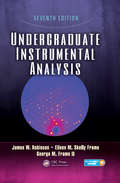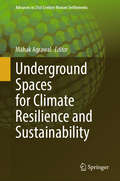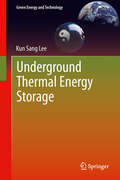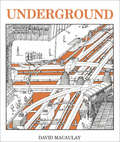- Table View
- List View
Undeniable: Evolution And The Science Of Creation
by Bill Nye Corey S. Powell"Evolution is one of the most powerful and important ideas ever developed in the history of science. Every question it raises leads to new answers, new discoveries, and new smarter questions. The science of evolution is as expansive as nature itself. It is also the most meaningful creation story that humans have ever found. "--Bill Nye <P> Sparked by a controversial debate in February 2014, Bill Nye has set off on an energetic campaign to spread awareness of evolution and the powerful way it shapes our lives. In Undeniable: Evolution and the Science of Creation, he explains why race does not really exist; evaluates the true promise and peril of genetically modified food; reveals how new species are born, in a dog kennel and in a London subway; takes a stroll through 4. 5 billion years of time; and explores the new search for alien life, including aliens right here on Earth. With infectious enthusiasm, Bill Nye shows that evolution is much more than a rebuttal to creationism; it is an essential way to understand how nature works--and to change the world. It might also help you get a date on a Saturday night.
Undeniable: Evolution and the Science of Creation
by Bill NyeThe popular scientist explains the marvels and mysteries of evolution in this “fun to read and easy to absorb” New York Times bestseller (The Washington Post).Evolution is one of the most powerful and important ideas ever developed in the history of science. Every question it raises leads to new answers, new discoveries, and new smarter questions. The science of evolution is as expansive as nature itself. It is also the most meaningful creation story that humans have ever found.—Bill NyeSparked by a controversial debate in February 2014, Bill Nye has set off on an energetic campaign to spread awareness of evolution and the powerful way it shapes our lives. In Undeniable: Evolution and the Science of Creation, he explains why race does not really exist; evaluates the true promise and peril of genetically modified food; reveals how new species are born in a dog kennel and in a London subway; takes a stroll through 4.5 billion years of time; and explores the new search for alien life, including aliens right here on Earth.With infectious enthusiasm, Bill Nye shows that evolution is much more than a rebuttal to creationism; it is an essential way to understand how nature works—and to change the world. It might also help you get a date on a Saturday night.“Mr. Nye writes briskly and accessibly [and] makes an eloquent case for evolution.” —The Wall Street Journal“Nye, known for delivering geeky intel with clarity and charm, takes on one of society’s most hotly debated topics (yes, still).” —Time Out New York
Under Alien Skies: A Sightseer's Guide to the Universe
by Philip PlaitA Financial Times Best Science Book of 2023 • A Science News Favorite Book of 2023 • A Scientific American 2023 Staff Recommendation "The next-best thing to traveling through space and time." —Laura Helmuth, editor in chief of Scientific American A rip-roaring tour of the cosmos with the Bad Astronomer, bringing you up close and personal with the universe like never before. Have you ever wondered what it would be like to travel the universe? How would Saturn’s rings look from a spaceship sailing just above them? If you were falling into a black hole, what’s the last thing you’d see before getting spaghettified? While traveling in person to most of these amazing worlds may not be possible—yet—the would-be space traveler need not despair: you can still take the scenic route through the galaxy with renowned astronomer and science communicator Philip Plait. On this lively, immersive adventure through the cosmos, Plait draws ingeniously on both the latest scientific research and his prodigious imagination to transport you to ten of the most spectacular sights outer space has to offer. In vivid, inventive scenes informed by rigorous science—injected with a dose of Plait’s trademark humor—Under Alien Skies places you on the surface of alien worlds, from our own familiar Moon to the far reaches of our solar system and beyond. Try launching yourself onto a two-hundred-meter asteroid, or stargazing from the rim of an ancient volcano on a planet where, from the place you stand, it is eternally late afternoon. Experience the sudden onset of lunar nightfall, the disorientation of walking—or, rather, shuffling—when you weigh almost nothing, the irritation of jagged regolith dust. Glimpse the frigid mountains and plains of Pluto and the cake-like exterior of a comet called 67P. On a planet trillions of miles from Earth, glance down to see the strange, beautiful shadows cast by a hundred thousand stars. For the aspiring extraterrestrial citizen, casual space tourist, or curious armchair traveler, Plait is an illuminating, always-entertaining guide to the most otherworldly views in our universe.
Under Ground: How Creatures of Mud and Dirt Shape Our World
by Yvonne BaskinIn childhood, the backyard, the flowerbed, the beach, puddles, lakes, and streams are infinitely fascinating. It is a mistake to leave that "childish" fascination with mud behind. The soils of the Earth, whether underneath our feet or pressurized beneath tons of ocean water, hold life in abundance. A handful of garden dirt may harbor more species than the entire aboveground Amazon.The robotic rovers Spirit and Opportunity made headlines as they searched the Martian landscape for signs of life. But while our eyes have been turned toward the skies, teeming beneath us and largely unexplored lies what Science magazine recently called the true "final frontier." A growing array of scientists is exploring life in soils and sediments, uncovering a living world alien to our own senses--and yet one whose integrity turns out to be crucial to life above ground. Yvonne Baskin takes the reader from the polar desert of Antarctica to the coastal rain forests of Canada, from the rangelands of Yellowstone National Park to the vanishing wetlands of the Mississippi River basin, from Dutch pastures to English sounds, and beyond. She introduces exotic underground creatures and shows us what scientists are learning about their contribution to sustaining a healthy world above ground. She also explores the alarming ways in which air pollution, trawl fishing, timber cutting, introductions of invasive species, wetland destruction, and the like threaten this underground diversity and how their loss, in turn, affects our own well being.Two-thirds of the world's biological diversity exists in soils and underwater sediments, and yet most of us remain unaware of these tiny multitudes that run the planet beneath the scenes. In Under Ground, Baskin reveals the startling ways in which that life, whether in our own back yards, in fields and forests, or in the furthest reaches of the Earth, is more significant and fascinating than we once imagined.
Under Michigan: The Story of Michigan's Rocks and Fossils
by Charles Ferguson BarkerMost people recognize Michigan by its mitten-shaped Lower Peninsula and the Great Lakes embracing the state. Underneath the earth's surface, however, is equally distinctive evidence of an exciting history. Michigan rests on sedimentary rocks that reach down into the earth's crust more than fourteen thousand feet-a depth three-and-a-half times deeper than the Grand Canyon. Within these layers of rock rest all sorts of ancient fossils and minerals that date back to the eras when tropical seas spread across Michigan and hot volcanoes flung molten rock into its skies-long before mile-thick glaciers bulldozed over Michigan and plowed through ancient river valleys to form the Great Lakes. Under Michigan is the first book for young readers about the geologic history of the state and the structure scientists call the Michigan Basin. A fun and educational journey, Under Michigan explores Earth's geological past, taking readers far below the familiar sights of Michigan and nearby places to explain the creation of minerals and fossils and show where they can be found in the varying layers of rock. Readers will learn about the hard rock formations surrounding Michigan and also discover the tall mountain ridges hidden at the bottom of the Great Lakes. With beautiful illustrations by author Charles Ferguson Barker, a glossary of scientific terms, and charming page to keep field notes, Under Michigan is a wonderful resource for young explorers to use at home, in school, or on a trip across Michigan.
Under Michigan: The Story of Michigan's Rocks and Fossils (Great Lakes Books Series)
by Charles Ferguson BarkerMost people recognize Michigan by its mitten-shaped Lower Peninsula and the Great Lakes embracing the state. Underneath the earth's surface, however, is equally distinctive evidence of an exciting history. Michigan rests on sedimentary rocks that reach down into the earth's crust more than fourteen thousand feet--a depth three-and-a-half times deeper than the Grand Canyon. Within these layers of rock rest all sorts of ancient fossils and minerals that date back to the eras when tropical seas spread across Michigan and hot volcanoes flung molten rock into its skies--long before mile-thick glaciers bulldozed over Michigan and plowed through ancient river valleys to form the Great Lakes.Under Michigan is the first book for young readers about the geologic history of the state and the structure scientists call the Michigan Basin. A fun and educational journey, Under Michigan explores Earth's geological past, taking readers far below the familiar sights of Michigan and nearby places to explain the creation of minerals and fossils and show where they can be found in the varying layers of rock. Readers will learn about the hard rock formations surrounding Michigan and also discover the tall mountain ridges hidden at the bottom of the Great Lakes. With beautiful illustrations by author Charles Ferguson Barker, a glossary of scientific terms, and charming page to keep field notes, Under Michigan is a wonderful resource for young explorers to use at home, in school, or on a trip across Michigan.
Under Osman's Tree: The Ottoman Empire, Egypt, and Environmental History
by Alan MikhailOsman, the founder of the Ottoman Empire, had a dream in which a tree sprouted from his navel. As the tree grew, its shade covered the earth; as Osman’s empire grew, it, too, covered the earth. This is the most widely accepted foundation myth of the longest-lasting empire in the history of Islam, and offers a telling clue to its unique legacy. Underlying every aspect of the Ottoman Empire’s epic history—from its founding around 1300 to its end in the twentieth century—is its successful management of natural resources. Under Osman’s Tree analyzes this rich environmental history to understand the most remarkable qualities of the Ottoman Empire—its longevity, politics, economy, and society. The early modern Middle East was the world’s most crucial zone of connection and interaction. Accordingly, the Ottoman Empire’s many varied environments affected and were affected by global trade, climate, and disease. From down in the mud of Egypt’s canals to up in the treetops of Anatolia, Alan Mikhail tackles major aspects of the Middle East’s environmental history: natural resource management, climate, human and animal labor, energy, water control, disease, and politics. He also points to some of the ways in which the region’s dominant religious tradition, Islam, has understood and related to the natural world. Marrying environmental and Ottoman history, Under Osman’s Tree offers a bold new interpretation of the past five hundred years of Middle Eastern history.
Under a Crimson Sun: Prospects for Life in a Red Dwarf System
by David S. StevensonGliese 581 is a red dwarf star some 20.3 light years from Earth. Red dwarfs are among the most numerous stars in the galaxy, and they sport diverse planetary systems. At magnitude 10, Gliese 581 is visible to amateur observers but does not stand out. So what makes this star so important? It is that professional observers have confirmed that it has at least four planets orbiting it, and in 2009, Planet d was described in the letters of The Astrophysical Journal as "the first confirmed exoplanet that could support Earth-like life." Under a Crimson Sun looks at the nature of red dwarf systems such as Gliese as potential homes for life. Realistically, what are prospects for life on these distant worlds? Could life evolve and survive there? How do these planetary surfaces and geology evolve? How would life on a red dwarf planet differ from life on Earth? And what are the implications for finding further habitable worlds in our galaxy? Stevenson provides readers with insight into the habitability of planets and how this changes as time progresses and the central star evolves. Explore with him in this engaging, fascinating book the possibilities for finding life, from bacteria to more complex and even intelligent organisms, on red dwarf system planets.
Under a White Sky: The Nature of the Future
by Elizabeth KolbertThe Pulitzer Prize–winning author of The Sixth Extinction returns to humanity&’s transformative impact on the environment, now asking: After doing so much damage, can we change nature, this time to save it? That man should have dominion &“over all the earth, and over every creeping thing that creepeth upon the earth&” is a prophecy that has hardened into fact. So pervasive are human impacts on the planet that it&’s said we live in a new geological epoch: the Anthropocene. In Under a White Sky, Elizabeth Kolbert takes a hard look at the new world we are creating. Along the way, she meets biologists who are trying to preserve the world's rarest fish, which lives in a single tiny pool in the middle of the Mojave; engineers who are turning carbon emissions to stone in Iceland; Australian researchers who are trying to develop a "super coral" that can survive on a hotter globe; and physicists who are contemplating shooting tiny diamonds into the stratosphere to cool the earth.One way to look at human civilization, says Kolbert, is as a ten-thousand-year exercise in defying nature. In The Sixth Extinction, she explored the ways in which our capacity for destruction has reshaped the natural world. Now she examines how the very sorts of interventions that have imperiled our planet are increasingly seen as the only hope for its salvation. By turns inspiring, terrifying, and darkly comic, Under a White Sky is an utterly original examination of the challenges we face.
Under the Ground: Seek, find and celebrate nature's treasures with the Natural History Museum (My Nature Collection)
by Cameron MenziesA stunning and interactive exploration of the natural world, celebrating the diversity of natural treasures under the ground and published in partnership with the Natural History Museum London.My Nature Collection: Under the Ground is filled with beautifully detailed artwork, highlighted natural treasures and hidden features to spot on every page. Dig deep into many remarkable underground habitats and get to know their special features, from diamondback rattlesnakes under the desert to deep roots under the prairie, from dinosaur fossils trapped in sandstone to rubies glinting in ancient marble. Search and find each wonder in context, with answers and further explanations at the back of the book.My Nature Collection book series encourages readers age 7 and up to look carefully and consider Earth's natural habitats in detail through interactive questions and up-close artwork. The perfect collection of books for treasure collectors, fact hunters and all lovers of nature!Series titles include: In the Rainforest / Under the Ground / Under the Sea / Up in the Air
Under the Ice: A Marine Biologist at Work
by Kathy ConlanKathy Conlan is a marine biologist who has scuba-dived in the Arctic and Antarctic. A fascinating first-person account of a woman scientist at work
Under the Radar
by Richard Mcgee M GossThis is the biography of Ruby Payne-Scott (1912 to 1981). As the first female radio astronomer (and one of the first people in the world to consider radio astronomy), she made classic contributions to solar radio physics. She also played a major role in the design of the Australian government's Council for Scientific and Industrial Research radars, which were in turn of vital importance in the Southwest Pacific Theatre in World War II and were used by Australian, US and New Zealand personnel. From a sociological perspective, her career also offers many examples of the perils of being a female academic in the first half of the 20th century. Written in an engaging style and complemented by many historical photographs this book gives a fascinating insight into the beginning of radio astronomy and the role of a pioneering woman in astronomy.
Under the Sea Wind
by Rachel CarsonThis New York Times bestseller by the author of the environmental classic Silent Spring beautifully details the coastal ecosystem of birds and the sea. In her first book, preeminent nature writer Rachel Carson tells the story of the sea creatures and birds that dwell in and around the waters along North America&’s eastern coast—and the delicately balanced ecosystem that sustains them. Following the life cycles of a pair of sanderlings, a mackerel, and an eel, Carson gracefully weaves scientific observation with imaginative prose to educate and inspire, creating one of the finest wildlife narratives in American literature. This ebook features an illustrated biography of Rachel Carson including rare photos and never-before-seen documents from the Beinecke Rare Book and Manuscript Library at Yale University.
Under the Sea with Jacques Cousteau
by Jackie Urbanovic Pam Hirschfeld Alan KramerSeveral ocean animals including crabs sea turtles and whales discuss their unique characteristics in anticipation of a visit from marine explorer Jacques Cousteau. Each animal hopes to be featured in one of Cousteau's TV documentaries.
Under the Sky We Make: How to Be Human in a Warming World
by Kimberly NicholasIt's warming. It's us. We're sure. It's bad. But we can fix it.After speaking to the international public for close to fifteen years about sustainability, climate scientist Dr. Nicholas realized that concerned people were getting the wrong message about the climate crisis. Yes, companies and governments are hugely responsible for the mess we're in. But individuals CAN effect real, significant, and lasting change to solve this problem. Nicholas explores finding purpose in a warming world, combining her scientific expertise and her lived, personal experience in a way that seems fresh and deeply urgent: Agonizing over the climate costs of visiting loved ones overseas, how to find low-carbon love on Tinder, and even exploring her complicated family legacy involving supermarket turkeys.In her astonishing book Under the Sky We Make, Nicholas does for climate science what Michael Pollan did more than a decade ago for the food on our plate: offering a hopeful, clear-eyed, and somehow also hilarious guide to effecting real change, starting in our own lives. Saving ourselves from climate apocalypse will require radical shifts within each of us, to effect real change in our society and culture. But it can be done. It requires, Dr. Nicholas argues, belief in our own agency and value, alongside a deep understanding that no one will ever hand us power--we're going to have to seize it for ourselves.
Underbug: An Obsessive Tale of Termites and Technology
by Lisa MargonelliWho has the answer to the world&’s fuel problems? How can we bring ruined land back to life? Where do roboticists turn when they try to engineer a hive mind? Termites. Strange though it may seem, scientists are looking to these much-reviled insects as little guides to the biggest of ideas. Lisa Margonelli follows them to find out how termites could change the world. A masterpiece of popular science, Underbug touches on everything from metaphysical meditation, technological innovation and the psychology of obsession to good old-fashioned biology.
Underbug: An Obsessive Tale of Termites and Technology
by Lisa Margonelli“Margonelli takes us on a termite-guided exploration of subterranean tracts of nature, science, and robotics. The book is brimming with flair.” ―Peter Godfrey-Smith, author of Other MindsThe award-winning journalist Lisa Margonelli, national bestselling author of Oil on the Brain: Petroleum’s Long, Strange Trip to Your Tank, investigates the environmental and economic impact termites inflict on human societies in this fascinating examination of one of nature’s most misunderstood insects.Are we more like termites than we ever imagined? In Underbug, the award-winning journalist Lisa Margonelli introduces us to the enigmatic creatures that collectively outweigh human beings ten to one and consume $40 billion worth of valuable stuff annually—and yet, in Margonelli’s telling, seem weirdly familiar. Over the course of a decade-long obsession with the little bugs, Margonelli pokes around termite mounds and high-tech research facilities, closely watching biologists, roboticists, and geneticists. Her globe-trotting journey veers into uncharted territory, from evolutionary theory to Edwardian science literature to the military industrial complex. What begins as a natural history of the termite becomes a personal exploration of the unnatural future we’re building, with darker observations on power, technology, historical trauma, and the limits of human cognition.Whether in Namibia or Cambridge, Arizona or Australia, Margonelli turns up astounding facts and raises provocative questions. Is a termite an individual or a unit of a superorganism? Can we harness the termite’s properties to change the world? If we build termite-like swarming robots, will they inevitably destroy us? Is it possible to think without having a mind? Underbug burrows into these questions and many others—unearthing disquieting answers about the world’s most underrated insect and what it means to be human.
Undercover
by Dale L. June Carmine J. MottoAn instructive and entertaining book for those public and private investigators who are potential undercover agents, this book approaches the topic from three angles: how to handle informants, how to investigate suspects, and how to be an undercover agent. Undercover places emphasis on the law enforcement agent but does not overlook the private investigator who may be assigned to work in an undercover role in business or industry.The first edition of this book quickly became the classic text for a whole generation of law enforcement personnel, and the name Carmine Motto, now retired from the secret service, is known throughout the country. Both authors contribute years of personal experience and use actual case anecdotes to focus attention on the triangle of interpersonal relationships among the informant, the suspect and the investigative agent. The motivations of the informant are detailed and analyzed to determine his reasoning and willingness to assist the investigator; the suspect is examined relative to his background, associates and capabilities; and, the investigative agent is instructed in protecting the identities of and handling of informants while gaining the confidence of the suspect. This edition of Undercover modernizes the writing, replaces the photographs, and updates the cases to provide insight into the highly intriguing and fascinating human intelligence and evidence gathering method that has captured the public's attention through movies, television and newspapers.
Undercover Gamer: Book 3 (Marie Curious, Girl Genius #3)
by Chris Edison50% Girl + 50% Genius = 100% Awesome!A brilliant new series with a heroine who uses her smarts - and her girl squad - to save the world from evil, one invention at a time.Marie's apprenticeship with tech giant Sterling Vance has already been a crazy adventure, from saving the world from a deadly computer virus to rescuing a global pop star, Marie thought she'd seen it all. But now Marie must face her most difficult challenge yet - going undercover!When Vance invests in a multi-million dollar eSports tournament,Marie and her three best friends are sucked into the world of professional gaming. Glitzy parties, infinity pools and the latest tech are all at their fingertips but when Vance discovers that someone in the tournament is cheating, it's left to Marie to infiltrate the GAME House where all the top gamers live, and find the culprit.The third installment in the Marie Curious, Girl Genius series sees Marie and her brainiac friends travel to Beijing, China!
Undergraduate Chemistry Education
by National Research Council Chemical Sciences Roundtable Division on Earth and Life Studies Joe Alper Board on Chemical Sciences and Technology Keegan SawyerUndergraduate Chemistry Education is the summary of a workshop convened in May 2013 by the Chemical Science Roundtable of the National Research Council to explore the current state of undergraduate chemistry education. Research and innovation in undergraduate chemistry education has been done for many years, and one goal of this workshop was to assist in the transfer of lessons learned from the education research community to faculty members whose expertise lies in the field of chemistry rather than in education. Through formal presentations and panel discussions, participants from academia, industry, and funding organizations explored drivers of change in science, technology, engineering and mathematics education; innovations in chemistry education; and challenges and opportunities in chemistry education reform. Undergraduate Chemistry Education discusses large-scale innovations that are transferable, widely applicable, and/or proven successful, with specific consideration of drivers and metrics of change, barriers to implementation of changes, and examples of innovation in the classroom.
Undergraduate Instrumental Analysis
by James W. Robinson Thomas J. Bruno Eileen M. Skelly Frame George M. Frame IIAnalytical instrumentation is crucial to research in molecular biology, medicine, geology, food science, materials science, forensics, and many other fields. Undergraduate Instrumental Analysis, 8th Edition, provides the reader with an understanding of all major instrumental analyses, and is unique in that it starts with the fundamental principles, and then develops the level of sophistication that is needed to make each method a workable tool for the student. Each chapter includes a discussion of the fundamental principles underlying each technique, detailed descriptions of the instrumentation, and a large number of applications. Each chapter includes an updated bibliography and problems, and most chapters have suggested experiments appropriate to the technique. This edition has been completely updated, revised, and expanded. The order of presentation has been changed from the 7th edition in that after the introduction to spectroscopy, UV-Vis is discussed. This order is more in keeping with the preference of most instructors. Naturally, once the fundamentals are introduced, instructors are free to change the order of presentation. Mathematics beyond algebra is kept to a minimum, but for the interested student, in this edition we provide an expanded discussion of measurement uncertainty that uses elementary calculus (although a formula approach can be used with no loss of context). Unique among all instrumental analysis texts we explicitly discuss safety, up front in Chapter 2. The presentation intentionally avoids a finger-wagging, thou-shalt-not approach in favor of a how-to discussion of good laboratory and industrial practice. It is focused on hazards (and remedies) that might be encountered in the use of instrumentation. Among the new topics introduced in this edition are: • Photoacoustic spectroscopy. • Cryogenic NMR probes and actively shielded magnets. • The nature of mixtures (in the context of separations). • Troubleshooting and leaks in high vacuum systems such as mass spectrometers. • Instrumentation laboratory safety. • Standard reference materials and standard reference data. In addition, the authors have included many instrument manufacturer’s websites, which contain extensive resources. We have also included many government websites and a discussion of resources available from National Measurement Laboratories in all industrialized countries. Students are introduced to standard methods and protocols developed by regulatory agencies and consensus standards organizations in this context as well.
Undergraduate Instrumental Analysis, Seventh Edition
by James W. Robinson Eileen Skelly Frame George M. FrameCrucial to research in molecular biology, medicine, geology, food science, materials science, and many other fields, analytical instrumentation is used by many scientists and engineers who are not chemists. Undergraduate Instrumental Analysis, Seventh Edition provides users of analytical instrumentation with an understanding of these instruments, covering all major fields of modern instrumentation. Following the tradition of earlier editions, this text is designed for teaching undergraduates and those with no analytical chemistry background how contemporary analytical instrumentation works, as well as its uses and limitations.
Underground Spaces for Climate Resilience and Sustainability (Advances in 21st Century Human Settlements)
by Mahak AgrawalThis book highlights the untapped potential of underground spaces as a pivotal resource for climate resilience and sustainable urban development. The book explores diverse perspectives, methodologies, and case studies that collectively illuminate the myriad ways in which subterranean environments can be harnessed to address the challenges of a changing climate and burgeoning urban populations. The book opens with an examination of Warsaw's Metro System, showcasing its role as a vital component in walkable urbanism, identifying best practices, and addressing existing barriers. Moving forward, the authors explore the integration of underground archeological spaces in Downtown Amman, emphasizing their contribution to climate adaptation and sustainable urban development. Chapters span the globe, from reviving underground practices to adapt to heat stress in unspecified locations, to unraveling the Qanat System of Yazd and its impact on urban climate resilience. "Rock Skin" introduces a process toward geological empathy, while the exploration of underground data centers and georadar technology in Jakarta highlights the technological advancements shaping the future of underground spaces. "Unveiling the Subterranean Frontier" also examines unconventional aspects such as reimagining subway station design, the utilization of underground spaces for geothermal energy, and the vital role of soil life as underground infrastructure for urban climate resilience. The book concludes with a chapter on synergies in sustainable underground space development, providing a holistic perspective on the subject. This timely and interdisciplinary compilation aims to contribute to the evolving discourse on urban resilience and sustainability, providing valuable insights for researchers, urban planners, and policymakers alike.
Underground Thermal Energy Storage
by Kun Sang LeeUnderground thermal energy storage (UTES) provide us with a flexible tool to combat global warming through conserving energy while utilizing natural renewable energy resources. Primarily, they act as a buffer to balance fluctuations in supply and demand of low temperature thermal energy. Underground Thermal Energy Storage provides an comprehensive introduction to the extensively-used energy storage method. Underground Thermal Energy Storage gives a general overview of UTES from basic concepts and classifications to operation regimes. As well as discussing general procedures for design and construction, thermo-hydro geological modeling of UTES systems is explained. Finally, current real life data and statistics are include to summarize major global developments in UTES over the past decades. The concise style and thorough coverage makes Underground Thermal Energy Storage a solid introduction for students, engineers and geologists alike.
Underground: El Subsuelo
by David MacaulayDavid Macaulay takes us on a visual journey through a city's various support systems by exposing a typical section of the underground network and explaining how it works. We see a network of walls, columns, cables, pipes and tunnels required to satisfy the basic needs of a city's inhabitants.
